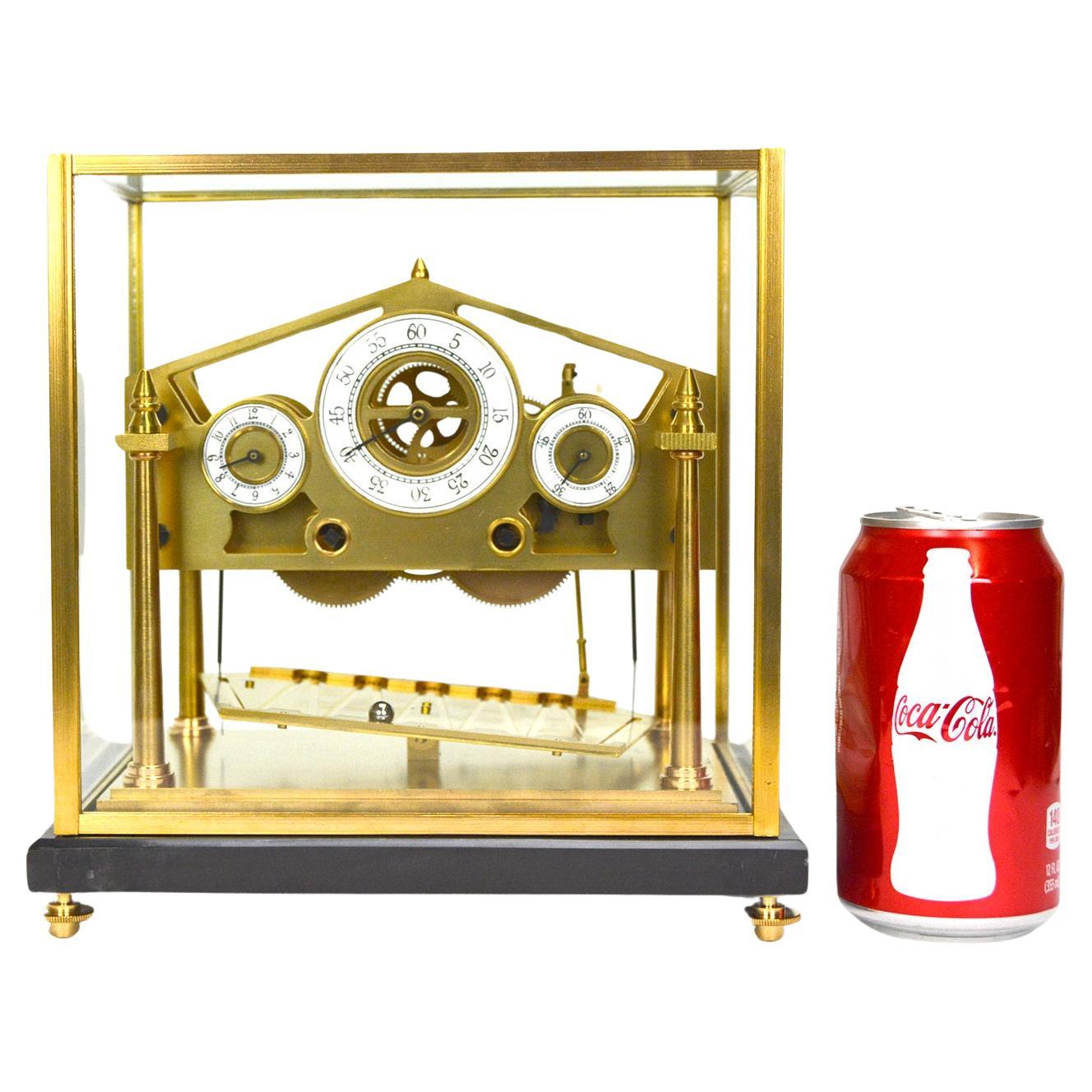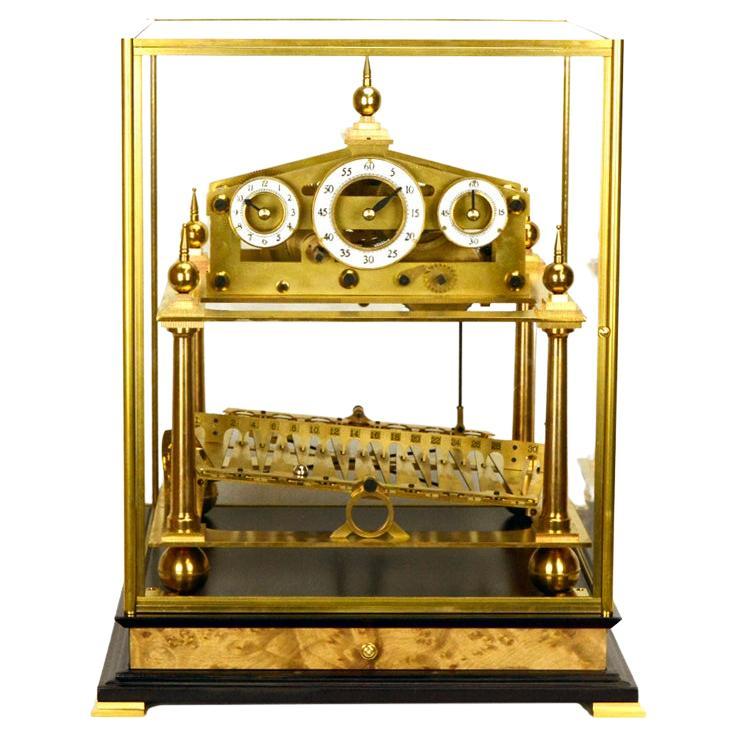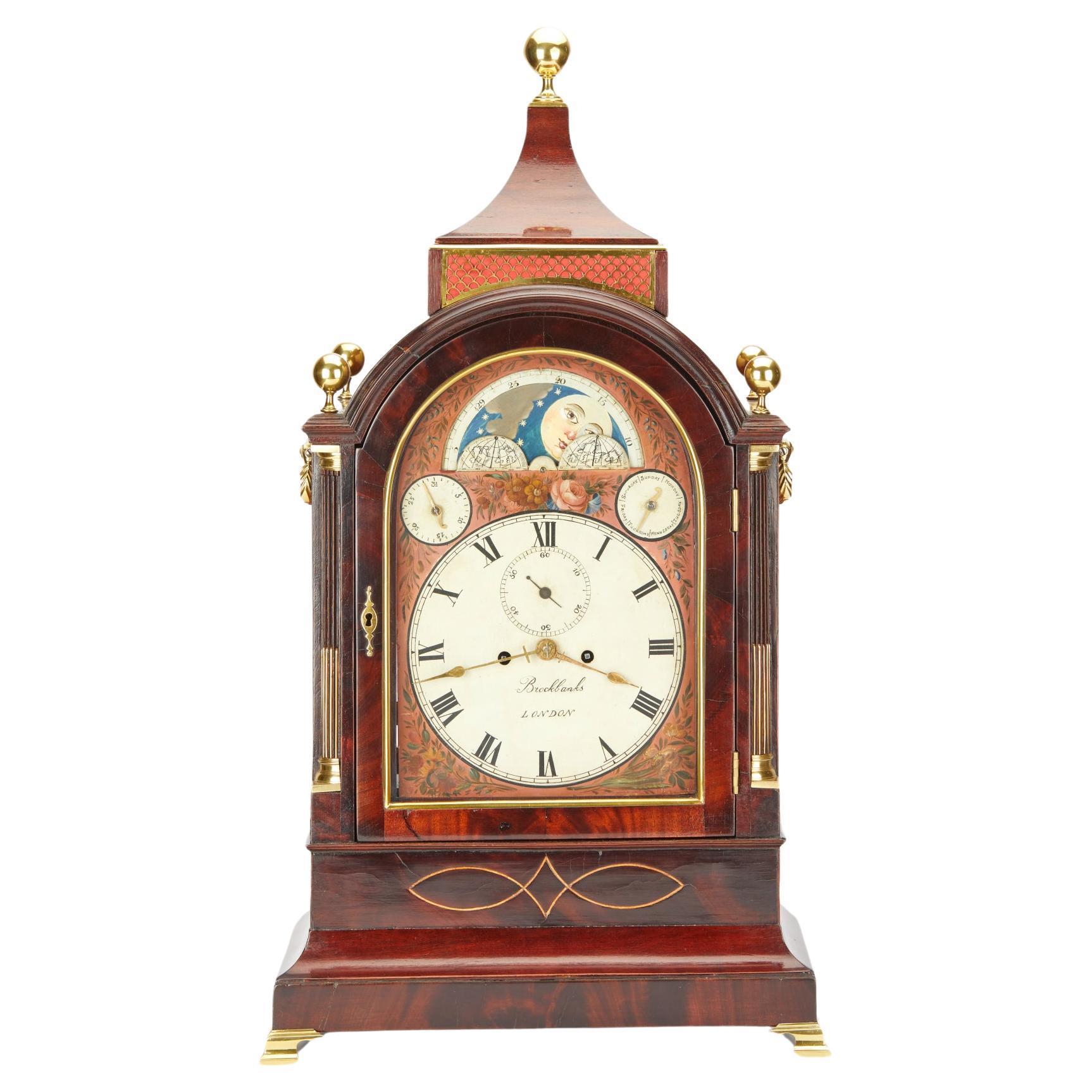Items Similar to Congreve Rolling Ball Clock by Thwaites & Reed, London
Want more images or videos?
Request additional images or videos from the seller
1 of 9
Congreve Rolling Ball Clock by Thwaites & Reed, London
About the Item
Congreve Rolling Ball Clock
Sir William was born in 1772 and died in 1828, son of General Sir William Congreve, 1st Baronet. He was a Tory member of parliament who immersed himself in inventing at the Royal Arsenal. Pioneering the development and deployment of Congreve rockets. He was a fellow of the Royal Society and enjoyed the friendship of the Prince Regent.
Congreve Rolling Ball Clock was invented by Sir William Congreve in 1808. Sir William was not a clockmaker but an inventor. He hired the well known firm of clockmakers Gravel and Tolkien to produce the first working version which was weight (rather than spring) driven. He presented this to the Prince of Wales in 1808. The second version which was spring driven was constructed by John Moxon and is now in the collection at Buckingham Palace.
The clock uses a steel ball rolling along a horizontal zig-zag track rather than a pendulum to regulate the time. The ball takes fifteen seconds to run from one end of the track to the other, where it trips the escapement which in turn reverses the tilt of the tray and causes the hands of the clock to move forward. Therefore, the second hand jumps forward at every fifteen second interval.
Congreve Rolling Ball clocks are unreliable timekeepers, the time taken for the ball to traverse the track can vary greatly depending on the circumstances of the ball and of the track.
This very fine example was made in 1973 by the famous London clockmaking firm of Twaites and Reed as a limited edition of 100. This one is numbered 49. The clock stands on a lacquered brass stepped base with rectangular ‘Zig-Zag’ table for the rolling ball and revolving seconds above. Gilded, reeded Corinthian columns support the architectural pediment with three silvered dials for seconds, minutes and hours. This magnificent timepiece rests on a mahogany stepped base with adjustable gilded feet. The silvered plaque to the base reads ‘This clock, No.49 of a limited edition of 100, made in 1973 by Thwaites and Reed Ltd’.
- Creator:Thwaites & Reed (Clockmaker)
- Dimensions:Height: 21.5 in (54.61 cm)Width: 18.5 in (46.99 cm)Depth: 12.5 in (31.75 cm)
- Materials and Techniques:
- Place of Origin:
- Period:
- Date of Manufacture:1973
- Condition:Wear consistent with age and use. very good condition.
- Seller Location:Norwich, GB
- Reference Number:
About the Seller
5.0
Vetted Seller
These experienced sellers undergo a comprehensive evaluation by our team of in-house experts.
1stDibs seller since 2018
58 sales on 1stDibs
Typical response time: 2 hours
Associations
The British Antique Dealers' AssociationLAPADA - The Association of Arts & Antiques Dealers
- ShippingRetrieving quote...Ships From: Norwich, United Kingdom
- Return PolicyThis item cannot be returned.
More From This SellerView All
- Regency Round Dial Wall Clock by Thwaites and Reed, LondonLocated in Norwich, GBEnglish round dial wall clock by Thwaites and Reed. Mahogany round dial wall clock with cast brass bezel opening to a painted twelve inch dial sign...Category
Antique 19th Century British Regency Wall Clocks
MaterialsMahogany
- Small Mahogany Mantel Clock by Webster, LondonBy Richard WebsterLocated in Norwich, GBSmall mahogany mantel clock by Webster, London Break arch case with applied carved decoration resting on a shaped stepped plinth and standing on four brass ball feet. Brass bezel opening to the silvered dial with Roman numerals, original ‘blued’ steel hands signed Webster, Queen Victoria Street, London. The hinged back door opening to the eight day movement with platform escapement striking the hours and halves on a coiled gong. The backplate of the clock also signed Webster. C.1880 The Webster family clockmaking business was founded by William Webster and passed from father to son for almost 200 years. William Webster was apprenticed to John Barnet in 1701 and then transferred to Thomas Tompion...Category
Antique 1880s English Late Victorian Mantel Clocks
MaterialsMahogany
- George I Longcase Clock by William Holloway, LondonLocated in Norwich, GBGeorge I longcase clock by William Holloway, London Georgian longcase clock in a finely figured mahogany case standing on a stepped ba...Category
Antique 1720s British Georgian Grandfather Clocks and Longcase Clocks
MaterialsMahogany
- George I Lacquered Longcase Clock by Peregrine Tawney, LondonLocated in Norwich, GBGeorge I Longcase Clock with gilt floral decorated to the sides. Long break arch trunk door with beautifully raised Chinoiserie scenes of pavilions and rural life. The plinth also ha...Category
Antique 1720s English George I Grandfather Clocks and Longcase Clocks
MaterialsFruitwood
- Georgian Mahogany Longcase Clock by John Taylor, LondonLocated in Norwich, GBGeorgian Longcase clock by John Taylor, London Finely figured flame mahogany case with stepped shaped plinth and inset panel to the bas...Category
Antique 1780s English Georgian Grandfather Clocks and Longcase Clocks
MaterialsMahogany
- Georgian Mahogany Bracket Clock by Hector Simpson, LondonLocated in Norwich, GBGeorgian mahogany bracket clock by Hector Simpson, London. Georgian bracket clock in a finely figured flame mahogany case standing on a r...Category
Antique 1780s British Georgian More Clocks
MaterialsMahogany
You May Also Like
- Miniature English William Congreve Rolling Ball ClockLocated in Danville, CAHere is a beautiful miniature Congreve rolling ball clock. This one comes with a solid marble display base and protective dome. The glass dome has solid brass frames. The clock is made of heavy solid brass. The time shows on 3 separated porcelain dials - second, minute, and hour. The clock is driven by a double spring movement. It is really fun to watch this clock running. It has an 8 DAY movement. The bigger version from our competitor wouldn't even run 8 days. Our smallest 8 day Congreve clock...Category
Late 20th Century Table Clocks and Desk Clocks
MaterialsBrass
- Thwaites and Reed 19th Century Wall ClockLocated in London, GBThis beautiful wall clock was made by Thwaites and Reed in the late 19th century. The case is mahogany and numbered 118 with a small ivorine plaque - these clocks were made for establishments such as the Inns of Court and the Bank of England in London. The company were also employed to service them. The clock is wound with the original key and has a lovely deep tick tock (no chime). The diameter of the clock face is 30cm. Thwaites and Reed are the epitome of a traditional English antique company...Category
Antique Late 19th Century British Late Victorian Wall Clocks
MaterialsBrass
- Mystery 8 Day Fusee Chain English Congreve Rolling Ball Clock with Bell StrikingLocated in Danville, CAA large beautiful mystery Congreve rolling ball clock. The original clock is invented by an English - Sir W. Congreve in 1808 and it's valued over $40,000 if you can find one. This one comes with a matching burl wood veneer display stand and protective dome. The glass dome has solid brass frames and it even has a front door, which allows you to wind the clock safely without lifting up the heavy glass dome. Veneered base has a drawer for storing the large winding key. This Congreve clock...Category
Early 2000s Table Clocks and Desk Clocks
MaterialsBrass
- Rare Vintage French Style Mystery 8 Day Waterwheel Rolling Ball Industrial ClockLocated in Danville, CAFor your consideration is a mystery Water Wheel Industrial Ball Bearing Clock. It comes with an 8 day movement and keeps very good time!! This water wheel industrial clock has a big paddle wheel on the right side which hold a a set of small steel ball bearings. The weight of these balls is propelling the clock. Please note the time shows a thin glass dial with Roman numerals. Every 60 seconds, a small ball drops down from the water wheel onto the track where the steel ball rolls to the left side. The bucket catches the ball and move it up one by one. Every 60 seconds, a steel ball drops from the left bucket on the channel to the waterwheel. Then the bucket drops down and go around to catch another ball bearing. The loops goes on as the clock keeps on running. The buckets chain is made of brass and nicely done. The power is received from an 8 day fusee movement inside the solid hardwood base, red ash. And the clock has a pendulum on the back to regulate the timing. The whole animation of this clock is just like a waterwheel except it's ball bearing "flowing" through channels and there is a clock on the big water wheel. The clock is protected by a glass dome. It measure 17-3/4" tall, 17-3/4" wide, and 8-3/4" deep including the glass dome. I'm sure this clock will upscale any clock store...Category
Late 20th Century Table Clocks and Desk Clocks
MaterialsBrass, Stainless Steel
- Bracket clock by Brockbanks LondonLocated in HAARLEM, NLA good English mahogany bracket clock with a very nice multi color decorated painted dial. Charming Moon phase. Date numbers of the mon...Category
Antique 18th Century English George III Mantel Clocks
MaterialsBronze
- A mahogany London bracket clock by BrockbanksLocated in HAARLEM, NLA very different English Regency, mid nineteenth century mahogany bracket clock with matching bracket, circa 1830. The case with arched top and side arched glass apertures, the corn...Category
Antique Early 19th Century English Regency Mantel Clocks
MaterialsBrass
Recently Viewed
View AllMore Ways To Browse
Rocket Clock Vintage
Congreve Clock
Congreve Rolling Ball Clock
Congreve Rolling Ball
Retro Silver Mantel Clock
Rolling Clock
Rocket Clock
Rolling Ball Clock
Thwaites And Reed
Horizontal Table Clock
Parliament Clock
Baronet Vintage Furniture
Weight Driven Clock Vintage
Mauthe Mantel Clock
Mauthe Mantel
Patek Philippe Range
Purple Porcelain Clocks
Smiths Mantel Clock Antique Clocks





